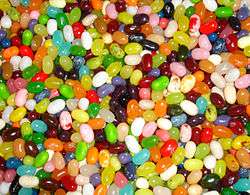Jelly bean
|
Jelly bean (Jelly Belly brand) flavor and color assortment | |
| Alternative names | Jelly Belly Beans |
|---|---|
| Type | Confectionery |
| Place of origin | United States |
| Creator | William Schrafft |
| Main ingredients | Sugar, corn syrup, starch |
|
| |
Jelly beans are small bean-shaped sugar candies with soft candy shells and thick gel interiors. The confection comes in a wide variety of colors and flavors, and is primarily made of sugar.
History
It is generally thought that jelly beans first surfaced in 1861, when Boston confectioner William Schrafft urged people to send his jelly beans to soldiers during the American Civil War. It was not until July 5, 1905, that jelly beans were mentioned in the Chicago Daily News. The advertisement publicised bulk jelly beans sold by volume for nine cents per pound, according to the book The Century in Food: America's Fads and Favorites. Today, most historians contend that jellybeans were first linked with celebrations of Easter in the United States sometime in the 1930s for their egg-like shape.[1]
The American National Jelly Bean Day is on April 22.[2]
Manufacture
The basic ingredients of jelly beans include sugar, corn syrup, and pectin or starch. Relatively minor amounts of the emulsifying agent lecithin, anti-foaming agents, an edible wax such as beeswax, salt, and confectioner's glaze are also included.[3] The ingredients that give each bean its character are also relatively small in proportion and may vary depending on the flavor.
Most jelly beans are sold as an assortment of around eight different flavors, most of them fruit-based. Assortments of "spiced" jellybeans and gumdrops are also available, which include a similar number of spice and mint flavors. The colors of jelly beans often correspond with a fruit and a "spiced" flavor.
Some premium brands, such as Jelly Belly and The Jelly Bean Factory, are available in many different flavors, including berry, tropical fruit, soft drink, popcorn, licorice, and novelty ranges, in addition to the familiar fruit and spice flavors. While these are also sold as assortments, individual flavors can be individually purchased from distributors. A version of the Bertie Botts Every Flavor Beans from the Harry Potter series was made commercially available and included flavors described as earwax, dirt, pepper, and vomit.
Slang

In the electronics industry, a "jelly bean" component is one which is widely available, used generically in many applications, and has no very unusual characteristics—as though it might be grabbed out of a jar in handfuls when needed, like jelly beans. For example, the 741 might be considered a jelly bean operational amplifier.
In United States slang in the 1910s and early 1920s, a "Jellybean" or "Jelly-Bean" was a young man who dressed stylishly to attract women but had little else to recommend him, similar to the older terms dandy and fop and the slightly later drugstore cowboy. F. Scott Fitzgerald wrote a story about such a character, The Jelly-Bean, in 1920.[4] In William Faulkner's 1929 novel The Sound and the Fury, Jason complained bitterly about his niece Quentin's promiscuity, remarking that even "the town jellybeans" gave her the "go-by".
The song "Jelly Bean (He's a Curbstone Cutie)" was made popular in the 1940s by Phil Harris. It was written by Jimmie Dupre, Sam Rosen, and Joe Verges and published in New Orleans in 1920 by Universal Music Publishers, Inc.
References
- ↑ "Jelly Beans: A Colorful History and Association with Easter". AT&T.
- ↑ Prince, John. "A Brief History of Jelly Beans". CandyFavorites.com. Retrieved 2015. Check date values in:
|access-date=(help) - ↑ "How Products are Made - Volumes - Jelly Beans". Gale-Edit. Retrieved 2010-02-19.
- ↑ Francis Scott Fitzgerald, Matthew Joseph Bruccoli, Judith Baughman, "The Jelly-Bean", Before Gatsby: the first twenty-six stories, p. 341
External links
| Wikimedia Commons has media related to Jelly beans. |
